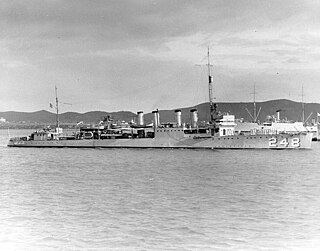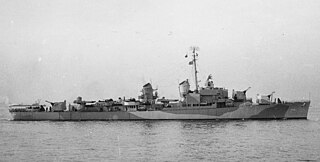
USS Dickerson (DD-157) was a Wickes-class destroyer in the United States Navy, and was converted to a high-speed transport at Charleston, South Carolina and designated APD-21 in 1943. She was named for Mahlon Dickerson (1770–1853), Secretary of the Navy from 1834 to 1838.

USS Roper (DD-147) was a Wickes-class destroyer in the United States Navy, later converted to a high-speed transport and redesignated APD-20.

USS Kleinsmith (APD-134), ex-DE-718, was a Crosley-class high speed transport for the United States Navy. She was named for Chief Watertender Charles Kleinsmith (1904–1942), who was posthumously awarded the Navy Cross for his heroism during the Battle of Midway.

Barry (DD-248/APD-29) was a Clemson-class destroyer in the United States Navy during World War II. She was the second ship named for Commodore John Barry.

USS Manley (DD-74/AG-28/APD-1), a Caldwell-class destroyer, served in the United States Navy. She was the second Navy ship named for Captain John Manley (c.1733–1793).

USS Goldsborough (DD-188/AVP-18/AVD-5/APD-32) was a Clemson-class destroyer in the United States Navy during World War II. She was the second Navy ship named for Rear Admiral Louis M. Goldsborough (1805–1877). Entering service in 1920, the ship had a brief active life before being placed in reserve in 1922. Goldsborough was reactivated for World War II and was used as an aircraft tender, destroyer and high speed transport in both Atlantic and Pacific theaters. Following the war, the ship was sold for scrapping in 1946.

USS Kane (DD-235/APD-18) was a Clemson-class destroyer in the United States Navy during World War II. She was the first ship named for Elisha Kent Kane.

USS Hale (DD-642), a Fletcher-class destroyer, was the second ship of the United States Navy to be named for Maine Senator Eugene Hale (1836–1918).

USS John R. Pierce (DD-753), an Allen M. Sumner-class destroyer, is the only ship of the United States Navy to be named for Lieutenant Commander John Reeves Pierce.

USS Schmitt (DE-676) was a Buckley-class destroyer escort in the United States Navy, commissioned in 1943. In late 1944, she was converted to a high speed transport and was redesignated APD-76. She was retired in 1949 and transferred to the Republic of China Navy in 1969, where she served as ROCS Lung Shan (PF-44) until 1976, when she was scrapped.

USS Burdo (APD-133) was a Crosley-class high speed transport of the United States Navy, in service from 1945 to 1958. She was finally sold for scrap in 1967. Burdo was named after Private Ronald A. Burdo (1920–1942), a Marine who was killed in action at Gavutu, during the Battle of Guadalcanal.

USS Hopping (DE-155) was a Buckley-class destroyer escort in service with the United States Navy from 1943 to 1947. In 1944, she was converted to a Charles Lawrence-class high speed transport and redesignated "APD-51". She was sold for scrap in 1966.

USS Reeves (DE-156/APD-52) was a Buckley-class destroyer escort in service with the United States Navy from 1943 to 1946. She was transferred to Ecuador for use as an electric generator plant in 1960. Her final fate is unknown.

USS Loy (DE-160/APD-56), a Buckley-class destroyer escort in service with the United States Navy from 1943 to 1947. She was converted to high-speed transport (APD) in late 1945. Following her decommissioning, she spent another 19 years in reserve before being sold for scrap in 1966.

USS Barber (DE-161/APD-57) was a Buckley-class destroyer escort in service with the United States Navy from 1943 to 1946. In 1969, she was sold to Mexico where she served until 2001.

USS Ottawa (AKA-101) was a Tolland-class attack cargo ship in service with the United States Navy from 1945 to 1947. She was sold into commercial service and was lost in 1951.

USS Laning (DE-159/APD-55) was a Buckley-class destroyer escort in service with the United States Navy from 1943 to 1946 and from 1951 to 1957. She was scrapped in 1975.

USS Hollis (DE-794/APD-86) was a Buckley-class destroyer escort in service with the United States Navy from 1944 to 1947 and from 1951 to 1956. She was scrapped in 1975.

USS Rednour (APD-102) was a Crosley-class high speed transport that served in the United States Navy from 1945 to 1946. In December 1969, she was transferred to Mexico and served as Chihuahua until July 2001.

USS Tollberg (APD-103) was a United States Navy high-speed transport in commission from 1945 to 1946. In 1965, Tollberg was transferred to Colombia and served as ARC Almirante Padilla (DT-03) until being stricken and scrapped in 1973.




















